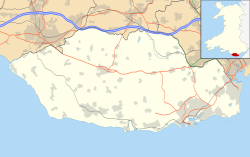Fonmon Castle
| Fonmon Castle | |
|---|---|
| Welsh: Castell Ffwl-y-mwn | |
| Fonmon, Vale of Glamorgan, Wales | |

Fonmon Castle in 2009
|
|
| Coordinates | 51°24′13″N 3°22′15″W / 51.4037°N 3.3708°W |
| Type | Historic house museum |
| Site information | |
| Owner | Private |
| Website | Fonmon Castle |
Fonmon Castle (Welsh: Castell Ffwl-y-mwn) is a fortified medieval castle near the village of Fonmon in the Vale of Glamorgan and a Grade I listed building. With its origins rooted in the 12th century it is today seen as a great architectural rarity, as it is one of few buildings that was drastically remodeled in the 18th century, but not Gothicized. The castle is believed to have remained under the ownership of just two families throughout its history; from Norman times the St Johns and from 1656 the descendants of Colonel Philip Jones.
The origins of Fonmon castle are poorly documented and most of its early history has been discovered through studying its architecture. A popular myth exists that the castle was built by Oliver St John of Fonmon was one of the Twelve Knights of Glamorgan who effected the Norman conquest of Glamorgan. It has since been shown that this was a legendary tale given credence by a "histroric" recount in the 1560s by Sir Edward Stradling.
There is speculation that a defensive fortification made of timber was built on the site of Fonmon Castle soon after the Norman invasion of Wales, with stonework added around 1200. The thick walls to the left of the entrance is easily identifiable as 12th century in design, and shows the existence of a rectangular keep. This keep was relatively small in size, approximately 8m x 13m. In the 13th century a curtain wall was added to the east side of the keep leading towards a steep scarp. This was followed by a much larger L-shaped build to the south with a south-east tower added at the angle. The east wall along the ravine edge has the castle's thickest walls, which is a curiosity as this would have been the most difficult side to attack. It is therefore believed that some other defensive structure may have existed to protect the more vulnerable south and west approaches. These early constructions are thought to have been undertaken by the St. John family (see Viscounts Bolingbroke), who were associated with the castle during the Middle Ages and continued as owners until 1656. It was not until the 16th century that the next major addition was made, a short north wing built over a barrel-vaulted semi-basement.
...
Wikipedia

